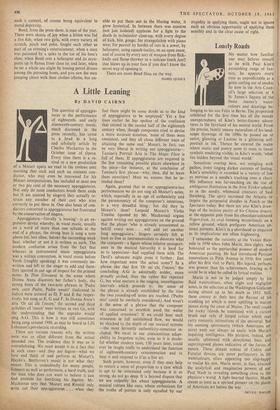Leaning A Little
By DAVI D CAIRNS
Appoggiatura—literally 'a leaning'—is an ex- pressive device whereby, in vocal music, usually on a word of more than one syllable at the end of a phrase, the strong beat is sung a note above (or, less often, below) the succeeding weak beat, whether or not it is written as such. The modern confusion arises from the fact that whereas in instrumental music appoggiatura was a written convention, in'vocal music before Verdi (roughly speaking) it was commonly un- written and left to the singer to add and there- fore ignored in our age of respect for the printed notes. In Don Giovanni in the scene where Donna Anna discovers her father's body, the strong beats of the two-note phrases in 'Padre tido, caro Padre, Padre amato' (indicated in italics) were notated as D, F and E flat respec- tively, but sung as E, G and F. In Donna Anna's aria 'Or sai chi l'onore,' the second and third syllables of 'onore' were written as two Gs, with the understanding that the soprano would sing A-G. This is how it was still sometimes being sung around 1900, as may be heard in Lilli Lehmann s pre-electric recording.
There are various reasons why the written note was so often different from the actual intended one. The evidence that it was so is overwhelming. We must accept it as a fact that in such cases—and they are legion—what we love and think of and perform as Mozart's, Haydn's, Beethoven's music is not what they meant. This is undoubtedly for many people, listeners as well as performers, a hard truth, and the man who does not want to believe it can find pretexts for fortifying his bigotry. Mr. Mackerras says that 'Mozart and Rossini only write out their appoggiaturas . . . when they
feel there might be some doubt as to the kind of appoggiatura to be employed.' Yet a few lines earlier he has spoken of the confusion that existed in the second half of the eighteenth century when, though composers tried to devise a more accurate notation, 'none of them were consistent, and they all chose, different ways of attaining the same end.' Mozart, in fact, can be very liberal in writing out appoggiaturas- Tamino's Portrait Aria in The Magic Flute is full of them. If appoggiaturas are required in the few remaining possible places elsewhere in the piece—for instance, at the conclusion of Tamino's first phrase—why, then, did he leave them unwritten? Must we assume that he in- tended them?
Again, granted that in our appoggiatura-less performances we do not sing all Mozart's notes, which, especially in an age of authenticity and the paramountcy of the composer's intentions, is a very dreadful thing: but did they in Mozart's time? Leopold Mozart's Violin Treatise (quoted by Mr. Mackerras) argues against writing out appoggiaturas on the ground that the player 'who is already accustomed to befrill every note . . . will add yet another long appoggiatura.' Singers certainly felt at least as free as instrumentalists to decorate what the compos'er—a figure whose relative unimport- ance in the musical hierarchy it is hard for us to appreciate—had supplied them with. The Devil's advocate might press it further: Just how important were 'the actual notes'? In a phrase like that first 'Or sai chi l'onore,' the concluding A-G is admittedly nobler, more proudly arched, than the rather flat repeated G, but what matters is the ringing, unambiguous intervals which precede it : the sense of the phrase is already established by the time the two rounding-off notes are reached. (Padre mio' could be similarly considered.) And wasn't it. the sense of a phrase that the composer was concerned to establish amid the welter of applied ornament? If we could hear such ornament in full uninhibited flow, we would be shocked to the depth of our musical systems —the most fervently authenticity-conscious in- cluded. We excel in our conscientious adapt- ability to forgotten styles; even so it is doubt- ful whether modern taste, 150 years later, could ever be taught really to understand the function of eighteenth-century ornamentation and to hear it and respond to it-as a live art.
Such points, however, even if they may help to restore a sense of proportion to a case which is apt to be overstated only because it is so strong, do not go deep. It is beyond dispute that we are culpably lax about appoggiaturas. A musical culture like ours, whose enthusiasm for the truths of purism is only equalled by our stupidity in applying them, ought not to ignore such an obvious opportunity of applying them sensibly and in the clear cause of right. •


































 Previous page
Previous page